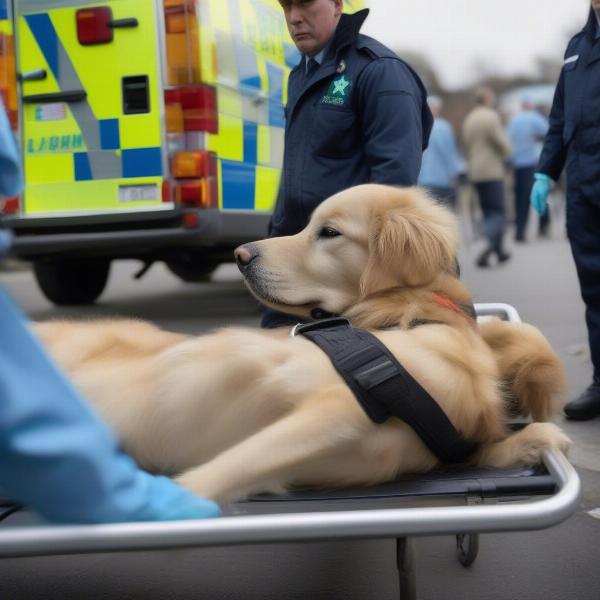A dog on a stretcher is a concerning sight for any pet owner. It often signals a serious medical emergency requiring immediate veterinary attention. While seeing your beloved companion in this situation can be distressing, understanding the potential reasons and knowing how to react can make a significant difference in their recovery. This article will guide you through common scenarios involving a dog on a stretcher, what to expect, and how to best support your furry friend during this challenging time.
Understanding Why a Dog Might Be on a Stretcher
Several reasons can lead to a dog needing a stretcher. These range from traumatic injuries to sudden illnesses. Recognizing some of the common causes can help you better understand the situation and communicate effectively with veterinary professionals.
- Trauma: Accidents, such as being hit by a car, falls, or fights with other animals, can cause severe injuries requiring immediate stabilization and transport. Fractures, internal bleeding, and spinal cord injuries are common in these cases.
- Collapse: Sudden collapse can indicate various underlying issues, including heart problems, heatstroke, poisoning, or severe allergic reactions.
- Neurological Issues: Conditions like seizures, strokes, or vestibular disease can impair a dog’s ability to walk, necessitating the use of a stretcher.
- Post-Operative Care: After major surgery, a dog might be temporarily unable to walk and require careful transfer using a stretcher.
 Dog on a Stretcher After an Accident
Dog on a Stretcher After an Accident
What to Do If Your Dog Needs a Stretcher
If you find yourself in a situation where your dog needs a stretcher, it’s crucial to remain calm and act swiftly. Your composure can help reassure your dog and allow you to make clear-headed decisions.
- Assess the Situation: Quickly evaluate the immediate surroundings for any further dangers and ensure your own safety.
- Call for Help: Immediately contact your veterinarian or an emergency animal hospital. Provide clear and concise information about the situation and your dog’s condition.
- Careful Handling: If you need to move your dog before professional help arrives, do so with extreme caution. Improper handling can worsen injuries, especially spinal cord damage. Use a flat, sturdy surface like a board or blanket as a makeshift stretcher and support the entire body. dog stretcher
- Keep Your Dog Calm: Speak to your dog in a soothing voice and try to keep them as still as possible. Covering them with a blanket can provide comfort and reduce anxiety.
At the Veterinary Clinic: What to Expect
Once at the clinic, the veterinary team will take over your dog’s care. They will perform a thorough examination to assess the extent of the injuries or illness.
- Triage: The vet will prioritize treatment based on the severity of the condition.
- Diagnostics: X-rays, blood tests, and other diagnostic procedures may be necessary to determine the underlying cause.
- Treatment: Treatment will depend on the diagnosis and may include pain medication, surgery, or other medical interventions.
- Recovery: The recovery process varies depending on the condition and can range from a few days to several months. The veterinary team will provide instructions on post-operative care, medication, and rehabilitation.
Long-Term Care and Considerations
After the initial emergency, your focus will shift to your dog’s long-term recovery. This can involve ongoing medication, physical therapy, or specialized diets. stretcher dog
- Follow Veterinary Instructions: Adhering to the vet’s recommendations is crucial for a successful recovery.
- Provide a Supportive Environment: Create a comfortable and safe space for your dog to rest and heal.
- Monitor for Changes: Be vigilant for any signs of complications and contact your vet immediately if you notice anything unusual.
Conclusion
Witnessing your dog on a stretcher is undoubtedly a stressful experience. However, by understanding the potential causes, knowing how to react in an emergency, and providing appropriate aftercare, you can significantly contribute to your dog’s well-being and recovery. Remember, staying calm, seeking prompt veterinary attention, and following professional advice are the key steps to helping your furry friend through this challenging time. dog bed stretcher
FAQ
- What should I do if my dog collapses suddenly? Immediately call your veterinarian or an emergency animal hospital.
- Can I move my dog myself if they are injured? If absolutely necessary, move them with extreme caution using a flat, sturdy surface, supporting the entire body.
- What diagnostic tests can I expect at the vet clinic? X-rays, blood tests, and other tests depending on the situation.
- How long will my dog need to stay on a stretcher? This depends on the severity of the injury or illness.
- What is the typical recovery time for a dog after an emergency? Recovery varies depending on the specific condition.
ILM Dog is a leading international online resource dedicated to providing dog owners with reliable and practical information on all aspects of dog care. We offer expert advice on dog breeds, health and medical care, training, nutrition, grooming, exercise, puppy care, senior dog care, traveling with dogs, and product reviews. If you have any further questions or need personalized advice, contact our team of experts at [email protected] or call us at +44 20-3965-8624. ILM Dog is here to support you and your furry friend on every step of your journey together.